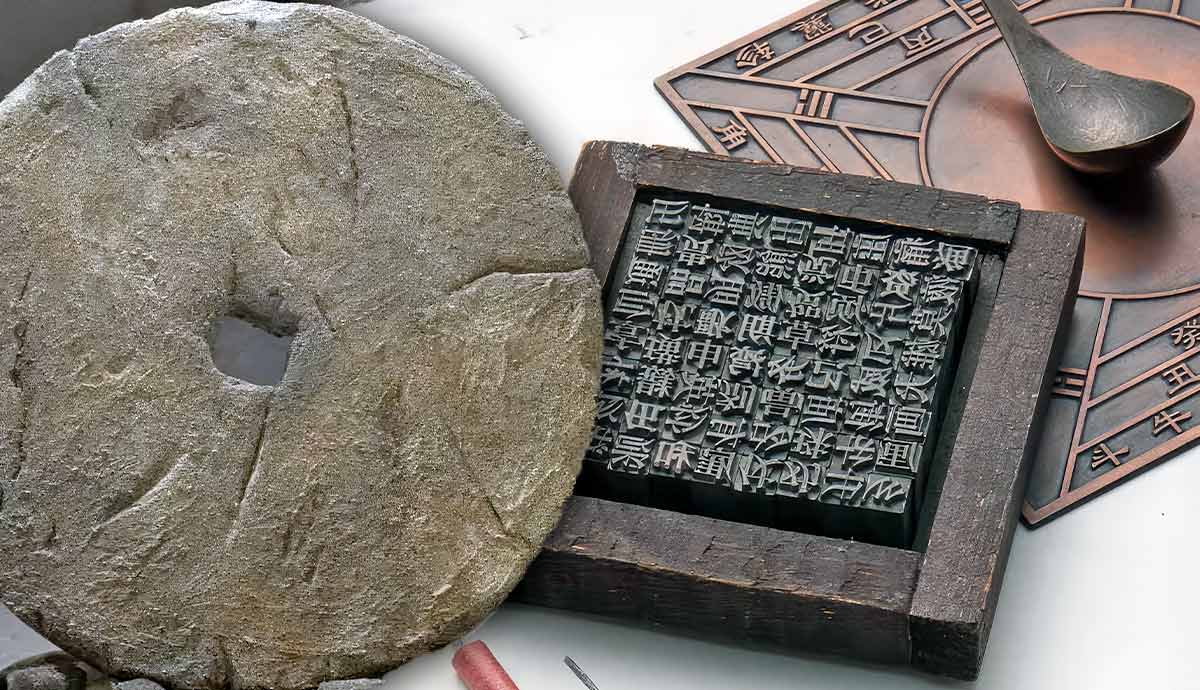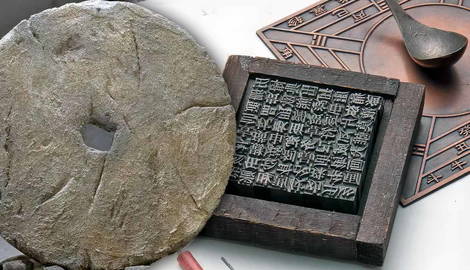
From the very beginning of civilization around 12 000 years ago, mankind has gone through several ages of intense creativity and invention. From farming to architecture, from entertainment to war, from politics to economics, all aspects of civilization have been subject to the minds of the inventors who shaped the futures of their civilizations. Here are 9 ancient inventions we use today which are a lot older than you may think.
1. The Magnetic Compass

One of the most important inventions in world history, the compass helped people navigate on both land and at sea. While today we have GPS tracking via satellites, it wasn’t until very recently that magnetic compasses were still being used all over the world, helping sea captains steer their ships in the right direction.
The magnetic compass is almost 2000 years old, and originates from Han China, from around 200 CE to 220 CE. For several centuries after its invention, however, it was used for geomancy and feng shui rather than navigation. It was only between 850 CE and 1050 CE that the compass started to be used for navigation. The first mention of the compass in Europe dates from 1190 and is from Alexander Neckam’s De naturis rerum (On the Natures of Things). It is unclear whether the invention found its way to the Middle East and Europe via China, or if these places invented the compass independently.
2. Paper

Before paper, we used a wide array of surfaces on which to record our thoughts, either as pictures or in the written word. The English word “paper” is derived from the Latin “papyrus” which was in turn taken from Greek. The Greek “papyrus” is thought to come from the Egyptian “pa-per-aa” meaning “of the pharaoh”, as the pharaoh controlled the production of the product.
The paper that we have today is made in a very different fashion, and it evolved not from Egypt, but from China. The pulp papermaking process is attributed to a court eunuch in the Han Dynasty named Cai Lun, who lived in the 2nd century CE. His method involved pressing wet wood pulp into a woven cloth and is a direct precursor to the process we use today. It took several hundred years for the technology to filter through to the Muslim and Christian worlds.
Despite the digitization of information these days, this ancient invention has not gone out of fashion. The global demand for paper is still expected to rise steadily throughout the next decade.
3. The Wheel

Modern civilization would look very different today had it not been for the ancient invention and incorporation of the simple wheel. Exactly where and when the wheel was invented remains unclear. It’s highly likely it was invented independently by many civilizations at one point or another. The simplicity of the wheel means that it’s likely to have been invented even by civilizations that saw no need for it.
The earliest evidence for the wheel comes from 4500 BCE to 3300 BCE in Mesopotamia in the form of the potter’s wheel. Early wheels for transport were made from solid planks of wood. This design was improved upon around 2200 BCE to 1550 BCE during the Middle Bronze Age when the spoked wheel and the chariot first appeared.
Today, the wheel is necessary for virtually all forms of transport. And it’s not just for land-based transport either. Airplanes require wheels to take off and land. Most helicopters have wheels too. Even maglev systems require extendable wheels when traveling at low speeds.
It’s not just in transport that wheels are important. Without gears and cogs, we’d probably still be stuck in the dark ages!
4. The Calendar

When human beings transitioned from hunter-gatherer societies towards sedentary life, farming became important, and the more important farming became, the more important it was to accurately predict the seasons. Since then, the calendar, in all its various forms, has been an integral and invaluable tool.
While timekeeping has been important since the Neolithic Era, the actual calendar wasn’t invented until the Bronze Age at around 3100 BCE. The Sumerians were the first known civilization to create a calendar. Their calendar was remarkably similar to our own, dividing the year into 12 lunar months, with each month consisting of 29 or 30 days. The Egyptians followed suit with a similar calendar also consisting of 12 months, but they also incorporated the star Sirius in tracking the days.
The Babylonians created a calendar that added a 13th month every two to three years. This calendar would later inspire the Jewish calendar. Many other civilizations had their own calendars with interesting twists, such as the Chinese, who incorporated the zodiac, and the Aztecs, whose solar year was 18 months, with each month consisting of 20 days, and each “century” being only 52 years. As with many other Meso-American civilizations, they inherited this system from the Mayans, who were expert mathematicians and astronomers.
5. Concrete

Concrete is an integral part of virtually all of mankind’s cities. It allows us to build solid structures that protect everything in society from the elements.
Early concrete was made by crushing or burning gypsum or limestone. Over the centuries and millennia, the ingredients and processes have changed, but the application remains largely unchanged.
The first use of concrete-like material was by the Nabataea Bedouin tribes of the Middle East around 6500 BCE. Since then, the Egyptians, Europeans living along the Danube, the Chinese, and the Greeks all had their own versions of concrete. Roman concrete was prolific and extremely advanced for the time.
Concrete today is an admixture of stones, sand, and water with various chemicals added. The chemicals that are added depend on the type of concrete, and its intended purpose. Geography and climate are also taken into account.
6. The Telescope

Conventional wisdom has it the telescope was invented in 1608 by Hans Lippersheyby, a Dutch spectacle maker. It is also widely known that the famed astronomer Galileo was among the first to use the telescope.
However, Galileo pointed out that people knew of, and used, telescopes thousands of years before he cast his eyes at the night sky.
Evidence of that notion lies in the Nimrud Lens, a 3000-year-old piece of polished rock crystal which has a 3 X Magnification property.
Although many academics are not convinced it was part of a telescope, or if it was even used to look at the stars and planets, it does fit in with the fact that the ancient Neo-Assyrians had an inordinate amount of knowledge about astronomy.
Either way, Galileo was convinced the ancients had telescopes long before him, and he was an expert on telescopes!
7. Central Heating

Central heating is often considered to be a modern luxury, but its existence dates back thousands of years. 7000 years ago, the Koreans were using a system called ondol which guided the heat from flames through tunnels underneath the floor.
This ancient invention, however, was independently invented by the Greeks several thousand years later, and their system used open spaces beneath the floor, which was raised on pillars. The Romans picked up this system and improved upon it, using it to heat the villas of the wealthy, as well as public baths. This system was called the hypocaust.
After the fall of the Roman Empire in Europe, much technology was incapable of being reproduced and for a thousand years, the Europeans reverted to heating the insides of their homes with basic fires.
8. Wine

For at least 8 000 years, wine has been challenging our sobriety. The earliest evidence for the production of wine comes from Georgia (the one in Eastern Europe), around 6000 BCE. Around the same time, however, evidence shows that in China, grapes and berries were being mixed with rice, and fermented to produce their own version of wine.
The intoxicating effect of this ancient invention was extremely popular, as one would expect, and as a result, it spread throughout the ancient world and became one of the most popular products in history — a trend that continues today.
9. Zero

The concept of nothing is not a particularly spectacular breakthrough, but it took a surprisingly long time for the concept to be realized as a symbol. The earliest record of the concept being used in written form comes from around 1770 BCE in Egypt. The ancient Egyptians used the hieroglyph nfr (meaning “beautiful”, “pleasant”, or “good”) to represent nothing, but it was used in a variety of other places as well.
The Babylonians used symbols to represent zero, but they were not used alone, and not used at the end of the number. As a result, many numbers were written the same, and could only be differentiated by context.
The Greeks made use of the Babylonian system but then converted their numbers back into Greek symbols. They seem to have had a philosophical problem with zero.
The Chinese used a system of rods to count, but again, the zero was only used as a placeholder, rather than a number.
It was the Indians in the 3rd to 2nd centuries BCE that created the notion of zero as we know it today. It was conceived of as a digit in its own right, and written in the decimal place to denote value. The symbol was a large dot which evolved into the symbol for zero that we have today.
Ancient Inventions: Conclusion
Many of the things today may be re-inventions of the past, but we cannot deny that the ancients, with their limited technology, were able to achieve extraordinary things, inventing the things we take for granted, and coming up with ideas that would evolve over time, and be implemented into the lives we live today.
FAQs
What was the impact of the invention of the compass on navigation?
The compass revolutionized navigation by providing a reliable means to determine direction, allowing sailors to explore new territories and trade routes with greater precision and safety.
How did the development of papermaking change the way information was recorded and disseminated?
Papermaking transformed information storage and sharing by replacing costly and bulky materials like stone and papyrus with a lightweight, versatile medium. This innovation spurred the proliferation of books, facilitating the spread of knowledge, ideas, and culture across civilizations.










